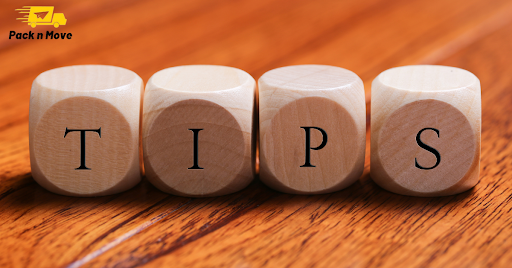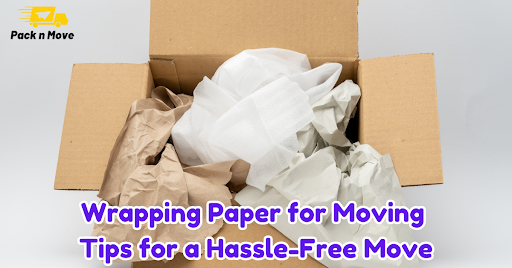Moving to a new home can be one of the most exciting experiences, but it often comes with a lot of stress and organization. One of the most important aspects of packing is ensuring your belongings are well-protected, especially the fragile items. Wrapping paper for moving serves as a lifesaver when it comes to safeguarding your delicate and valuable possessions. This simple yet effective material helps prevent damage during transport and can make the packing process much more organized.
In this article, we’ll explore everything you need to know about wrapping paper for moving, from its benefits and where to buy it, to the best ways to use it and creative ways to reuse it after your move. So, let’s dive into the world of packing paper and make your move as smooth and safe as possible.
What Is Wrapping Paper for Moving and Why Do You Need It?
Wrapping paper for moving is a specially designed type of paper used to protect items during transport. It is often made from soft, clean materials like newsprint paper or Kraft paper, and it’s free from any inks or dyes that could damage your belongings. Unlike regular paper, it is designed to be lightweight and durable, making it ideal for wrapping up delicate items such as glassware, porcelain, and fine china.
The main reason you need wrapping paper when moving is its ability to protect fragile items during the packing process and the move itself. Whether you’re moving across town or to a new state, your belongings will encounter some bumpy roads along the way. By using packing paper, you create a protective cushion that absorbs impacts and prevents your valuable items from breaking.
Key Benefits of Using Wrapping Paper for Moving
When it comes to packing, wrapping paper offers a variety of advantages that make it one of the most reliable materials for moving. Here are the key benefits:
Protects Fragile Items
One of the primary reasons to use wrapping paper is its ability to safeguard fragile objects like glass objects, porcelain items, and wooden pieces. Wrapping your delicate items in several layers of soft packing paper creates a cushioning effect that prevents them from getting scratched, dented, or chipped.
Eco-Friendly Solution
In an era where sustainability matters, eco-friendly packing materials are becoming more popular. Many types of wrapping paper are recyclable and compostable, making it an excellent choice for an eco-friendly move. Instead of using plastic or bubble wrap, which can take hundreds of years to decompose, wrapping paper offers a greener alternative that can easily be disposed of or reused.
Cost-Effective
Compared to other packing materials like bubble wrap or foam pouches, wrapping paper is relatively affordable. It’s easy to find at major stores like Walmart, The Home Depot, and Lowe’s, and it comes in bulk quantities that ensure you have enough for your entire move. For those on a budget, wrapping paper is a great option to keep packing costs low.
How to Use Wrapping Paper to Protect Fragile Items

Knowing how to properly wrap your fragile items with packing paper is crucial to ensuring they remain intact during the move. Here’s a step-by-step guide to help you protect your delicate items:
- Start with the Right Paper: Choose clean packing paper (unprinted newsprint or brown Kraft paper). Make sure it’s soft and free from ink, which could transfer onto your items.
- Wrap Each Item Individually: Lay the item flat on the paper and fold the edges around it, making sure the paper covers the entire object. For larger items like kitchen dishes, you may need to use multiple sheets of paper to provide sufficient coverage.
- Add Extra Padding for Fragile Items: For extremely fragile items like glassware or fine china, you should place additional padding inside the wrapping. This can be done by crumpling some packing paper into small balls and placing them inside the moving boxes to act as cushioning.
- Seal It Tight: After wrapping each item, use packing tape to secure the paper and keep it from unraveling. This is especially important for items that will be stacked in boxes, ensuring that the paper stays in place during transport.
By following these simple steps, your fragile items will be well-protected and safe during your move.
Best Places to Buy Wrapping Paper for Moving
If you’re wondering where to buy wrapping paper for your move, here are some of the best places to consider:
Local Stores
- Walmart: Known for offering a wide range of moving supplies, including wrapping paper, packing tape, and moving boxes.
- The Home Depot: A go-to destination for quality packing materials, including newsprint and brown Kraft paper.
- Lowe’s: Another home improvement store that carries an assortment of affordable packing supplies for moving.
Online Retailers
- Amazon: Offers convenient options for bulk purchasing, with quick delivery right to your doorstep.
- Target: Has a variety of eco-friendly packing options available, including wrapping paper.
- Bed Bath & Beyond: While known for home goods, they also offer a great selection of moving supplies.
Professional Movers
Some professional moving companies offer packing materials as part of their services. If you’re using a moving company like Penske or Budget, ask if they provide wrapping paper or if you need to purchase it separately.
Free Alternatives to Wrapping Paper
If you’re looking to save money or are simply running low on wrapping paper, there are several free alternatives you can use to protect your belongings:
1. Newspaper
Newspaper is a great option, especially for padding boxes and packing dishes. While the ink can sometimes transfer, it works well for items that won’t be visibly affected by the print.
2. Household Items
Use old towels, blankets, or even clothing to wrap up your fragile items. This is a cost-effective way to protect your belongings, and you can still reduce waste by reusing items you already have.
3. Online Communities
If you’re really trying to save, check out local online platforms like Craigslist, Freecycle, or even Facebook Marketplace. Many people give away their old newspapers or wrapping paper for free after they’ve completed their own move.
How Much Wrapping Paper Do You Need for Moving?
Estimating how much wrapping paper you need can be tricky, but it’s important to get it right to avoid running out mid-move. Here’s a general guide to help you:
- Small Moves (1-2 Bedroom): For smaller apartments or homes, around 10-15 pounds of wrapping paper should be sufficient.
- Medium Moves (3-4 Bedrooms): If you have a larger home with more fragile items, you’ll need about 20-30 pounds.
- Large Moves (5+ Bedrooms): For big family homes, you may need 40-50 pounds or more of packing paper.
The amount needed also depends on how many fragile items you’re moving. Consider how many dishes, glassware, and breakables you have in order to calculate how much you’ll need.
Creative Ways to Use Wrapping Paper After the Move
Once your move is over, you don’t need to toss the leftover wrapping paper. Here are some creative ways to use it:
1. Recycling
The most obvious option is to recycle your wrapping paper. Many types of newsprint and Kraft paper can be easily recycled at your local recycling center.
2. Garden Mulch
If you have a garden, crumpled packing paper can serve as an excellent mulch alternative, helping retain moisture and prevent weeds from growing.
3. Crafting Projects
Another fun idea is to repurpose wrapping paper for crafts. Whether it’s for making cards, wrapping small gifts, or creating DIY projects, wrapping paper can have a second life.
Additional Packing Materials to Use with Wrapping Paper
While wrapping paper is great for many items, it’s not the only packing material you should rely on. For a successful move, you’ll need to combine various packing materials. Some of the most essential materials to use alongside wrapping paper include:
- Bubble Wrap: Perfect for extra protection around delicate items like electronics and glassware.
- Packing Tape: Ensure your boxes are securely sealed to prevent any spills or damage.
- Cardboard Boxes: Use strong, durable moving boxes to house your wrapped items. It’s also helpful to use smaller boxes for heavier items and larger boxes for lighter items.
Pro Tips for Packing Efficiently with Wrapping Paper

Packing can be overwhelming, but following a few expert tips can help streamline the process:
1. Start Early
Don’t wait until the last minute to start packing. Begin with the non-essential items and work your way toward the things you use daily.
2. Label Everything
Make sure to label each box clearly with its contents, especially fragile items. This will help movers know which boxes require special care.
3. Pack Smartly
Use smaller boxes for heavier items, and fill any empty spaces with crumpled wrapping paper to prevent shifting. Avoid overpacking boxes, as this can lead to crushing or breaking.
Common Mistakes to Avoid When Using Wrapping Paper for Moving
To ensure a smooth moving process, avoid these common packing mistakes:
- Underestimating How Much Paper You Need: Running out of wrapping paper mid-move can cause unnecessary stress. Always overestimate the amount of packing paper you’ll need.
- Improperly Wrapping Items: Wrapping only part of an item or not using enough paper can leave it vulnerable to damage. Make sure to cover every corner and edge.
By following these tips and avoiding mistakes, your move will be much smoother.
Conclusion
Using wrapping paper for your move is one of the easiest ways to protect your fragile belongings. Not only is it affordable, but it’s also an eco-friendly and effective packing material. Whether you’re moving a few blocks or across the country, wrapping paper will help ensure that your fragile items arrive safely.
With the right amount of wrapping paper, packing techniques, and other materials, you’ll be ready for a stress-free move that protects both your possessions and the environment. Happy moving!
Frequently Asked Questions (FAQs)
Q. Can I use regular newspaper for packing?
Yes, but be careful of ink stains. If you’re packing delicate items like white china, it’s better to use newsprint or Kraft paper.
Q. How do I recycle wrapping paper after moving?
Recycling is the most common way to dispose of wrapping paper. Just check if it’s free from any non-recyclable materials like plastic coatings.
Q. How can I pack delicate items without wrapping paper?
You can use old towels, clothing, or bubble wrap as an alternative. Just ensure that it’s soft enough to prevent damage.
Q. Do I really need to wrap everything?
Not everything needs to be wrapped, but it’s important to wrap fragile items like glass, porcelain, and electronics to avoid damage.
Q. Can I use wrapping paper for other things after my move?
Absolutely! You can recycle it, use it in crafts, or even use it as mulch in your garden.
